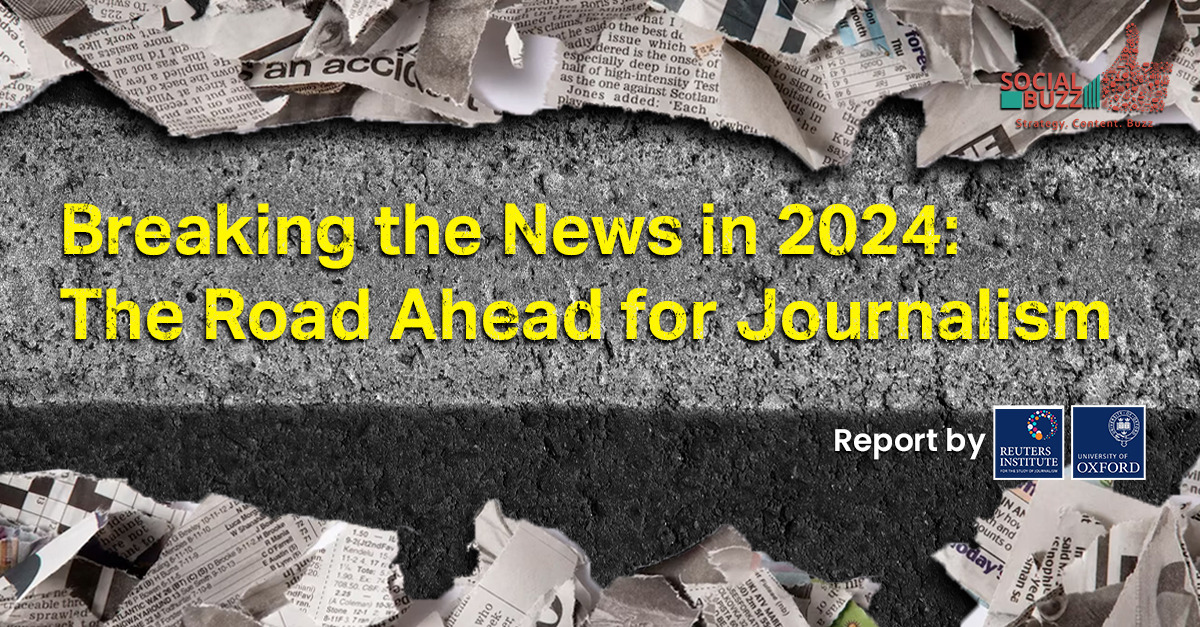Breaking the News in 2024: The Road Ahead for Journalism

INTRODUCTION
People actively consider journalism as the fourth pillar of democracy. Amid global issues, we turn to news publishers for current affairs, but with advancing technology and shorter attention spans influenced by social media trends, these organizations face the risk of becoming endangered. As the world enters a new year, media organizations are skeptical about surviving in a tech-driven generation where brevity seems essential, with content ideally lasting 30 seconds.
This blog aims to decode a 46-page report by Nic Newman, published by Reuters Institute for the Study of Journalism in collaboration with the University of Oxford. The aim of delivering this is to decode statistics, especially those pertaining to trends in journalism.
Is 2024 shining a green light for Journalism?
When asked about the prospects of journalism for the year 2024, CEOs, editors, and digital leaders had varying responses. 47% expressed confidence, while a majority of them either lacked confidence or were uncertain.
Phil Chetwynd, the Global News Director of AFP commented, “We’re seeing turbulence amongst our client base over unstable advertising revenues and concern about referral traffic from social media.”
With elections in nearly 40 democratic countries this year, including India and the USA, publishers are optimistic about sustainable growth through digital channels.
“The polarization of opinion, driven by social media, poses one of the most difficult challenges to the core mission of journalists,” says one senior editor.
Social Media: Boon or Bane?
The report also talks about how Social Media Platforms are no longer prioritizing news over other content. In 2023, statistical data from a report reveals that Meta, the parent company of popular social media platforms like Instagram and Facebook, is actively devaluing news-related discourse. Media giants like Buzzfeed and Vice Media, reliant on these platforms for discourse, face a looming downturn.
“’Both Facebook and X/Twitter as a place for traffic – or even news consumption – are pretty much dead for news organizations in India”’ notes one leading editor responding to the survey by Newman.
Furthermore, Newman explains the two reasons for the decline of traditional social media platforms like Facebook and X (formerly Twitter). He asserts that the primary reason is the spread of toxicity through handles, particularly centered around politics. This generation consumes more video content, boosting the popularity of platforms like TikTok and YouTube.
The increased demand for video content poses a challenge for traditional media organizations lacking skills in creating engaging short videos. Influencers, adept at using slangs and strategies, are pushing media organizations to rethink their strategies amid platform competition.
The image above reveals that esteemed media organizations like New York Times and BBC News receive fewer views compared to a young TikTok influencer.
The Masterplan in Progress
Doors may be closing for news publishers on mainstream social media platforms. However, over 77% of respondents, when asked about their strategies for the year ahead, are positive about investing more in direct channels to reach the audience.
With WhatsApp rolling out a new feature, Channels, which follows a similar algorithm to that of X. This new feature on the global communication platform serves as a boon for media organizations to reach a wider audience.
The Audio-Visual Medium
News no longer comes solely in long paragraphs on recycled sheets of paper. The researcher observes a rising trend of consuming news through video, newsletters and podcast format. In the survey snippet above, it is clear that 64% publishers are leaning into creating video content. Media organizations are adopting trends such as vertical videos, podcast-style videos, and paid podcasts.
Content Overload Dilemma
As we discussed how the media organizations are trying to attract more audiences by producing a variety of content over different formats, we fail to recognize the fact that this can get overwhelming for the audience too. In times like these, many people tend to ignore or avoid the notifications and thereby reduce the screen time.
This survey shows how the media organizations are planning to tackle the problem of news avoidance. 67% believe that simplifying complex stories can enhance news consumption by reducing the need for deep thought. Only 18% think entertaining news helps, and 21% advocate for positive news. as a solution.
Conclusion
Although a major proportion of the media organizations acknowledge the threat looming over them, the new year also symbolizes hope. These organizations, armed with new methods and skills, are boldly stepping into the future of journalism in 2024.
We’ll explore the intriguing intersection of Artificial Intelligence in journalism and its potential impact on the scope of media organizations. For that, stay tuned for our next blog!
To know more about the state of digital marketing in India, Click here.
About the Author:
Gopika Nair is a media student currently pursuing her postgraduate degree from GGSIPU. With a flair for poetry and a keen eye for photography, she aspires to harness the power of storytelling. The goal is to create a positive impact.




Comment (01)